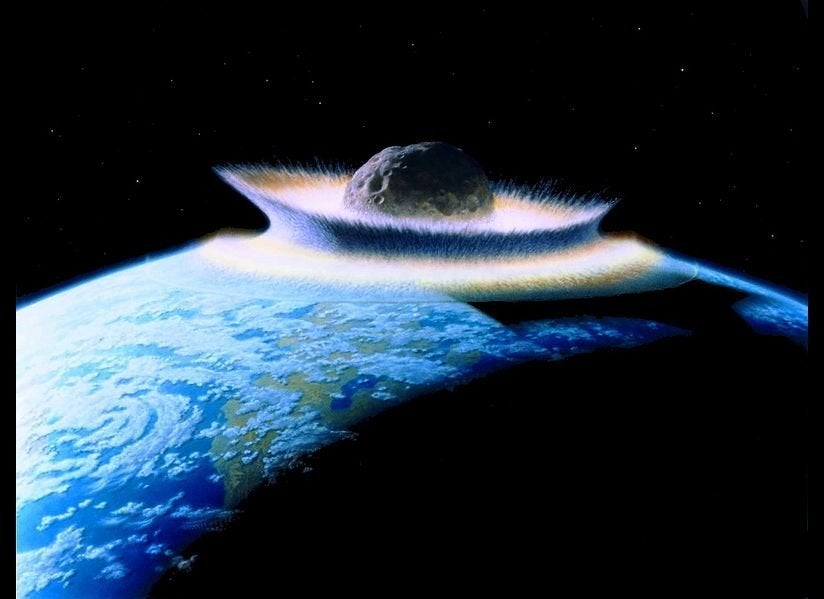A big asteroid that flew past Earth last month belongs to a new category of space rock, scientists say.
Asteroid 1998 QE2 and its moon sailed within 3.6 million miles (5.8 million kilometers) of Earth on May 31, making their closest approach to our planet for at least the next two centuries. New radar images captured by the Arecibo Observatory in Puerto Rico are revealing just how unique this binary asteroid is, researchers say.
“Asteroid QE2 is dark, red, and primitive — that is, it hasn’t been heated or melted as much as other asteroids," Arecibo's Ellen Howell said in a statement. "QE2 is nothing like any asteroid we've visited with a spacecraft, or plan to, or that we have meteorites from. It's an entirely new beast in the menagerie of asteroids near Earth." [Potentially Dangerous Asteroids (Images)]
The 1000-foot-wide (305 meters) Arecibo dish and NASA's 230-foot (70 m) Deep Space Network antenna in Goldstone, Calif., tracked 1998 QE2 as it approached Earth last month, then kept following the near-Earth asteroid as it receded into the depths of space.
The resulting radar images have helped researchers take 1998 QE2's measure. The dark, cratered main asteroid is 1.9 miles (3 km) wide, and it has a 2,500-foot (750 m) moon that orbits it once every 32 hours.
"QE2's moon is roughly one-quarter the size of the main asteroid," Patrick Taylor, also of Arecibo, said in a statement. "Similarly, our moon is also approximately one-fourth the size of our planet."
Studying the moon and its orbit should help scientists determine the mass of the main asteroid, which in turn will shed light on the object's composition, researchers said.
Asteroid 1998 QE2 was discovered in August 1998 by astronomers working with MIT's Lincoln Near Earth Asteroid Research program in New Mexico. The space rock completes one lap around the sun every 3.8 years.
There was never any danger of 1998 QE2 hitting Earth during last month's flyby, scientists say. If it had hit us, the damage would have been severe; researchers think that any asteroid bigger than 0.6 miles (1 km) is capable of inflicting damage on a global scale, primarily by altering the planet's climate.
1998 QE2 is one of roughly 10,000 near-Earth asteroids that have been spotted to date. The total population of close-flying space rocks is thought to exceed 1 million.
Arecibo's observing campaign of 1998 QE2 came to end on Thursday (June 13), observatory officials said.
Follow Mike Wall on Twitter @michaeldwall and Google+. Follow us @Spacedotcom, Facebook or Google+. Originally published on SPACE.com.
Copyright 2013 SPACE.com, a TechMediaNetwork company. All rights reserved. This material may not be published, broadcast, rewritten or redistributed.
Support HuffPost
Our 2024 Coverage Needs You
Your Loyalty Means The World To Us
At HuffPost, we believe that everyone needs high-quality journalism, but we understand that not everyone can afford to pay for expensive news subscriptions. That is why we are committed to providing deeply reported, carefully fact-checked news that is freely accessible to everyone.
Whether you come to HuffPost for updates on the 2024 presidential race, hard-hitting investigations into critical issues facing our country today, or trending stories that make you laugh, we appreciate you. The truth is, news costs money to produce, and we are proud that we have never put our stories behind an expensive paywall.
Would you join us to help keep our stories free for all? Your contribution of as little as $2 will go a long way.
Can't afford to donate? Support HuffPost by creating a free account and log in while you read.
As Americans head to the polls in 2024, the very future of our country is at stake. At HuffPost, we believe that a free press is critical to creating well-informed voters. That's why our journalism is free for everyone, even though other newsrooms retreat behind expensive paywalls.
Our journalists will continue to cover the twists and turns during this historic presidential election. With your help, we'll bring you hard-hitting investigations, well-researched analysis and timely takes you can't find elsewhere. Reporting in this current political climate is a responsibility we do not take lightly, and we thank you for your support.
Contribute as little as $2 to keep our news free for all.
Can't afford to donate? Support HuffPost by creating a free account and log in while you read.
Dear HuffPost Reader
Thank you for your past contribution to HuffPost. We are sincerely grateful for readers like you who help us ensure that we can keep our journalism free for everyone.
The stakes are high this year, and our 2024 coverage could use continued support. Would you consider becoming a regular HuffPost contributor?
Dear HuffPost Reader
Thank you for your past contribution to HuffPost. We are sincerely grateful for readers like you who help us ensure that we can keep our journalism free for everyone.
The stakes are high this year, and our 2024 coverage could use continued support. If circumstances have changed since you last contributed, we hope you’ll consider contributing to HuffPost once more.
Already contributed? Log in to hide these messages.

